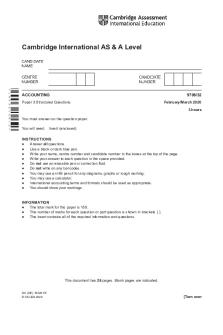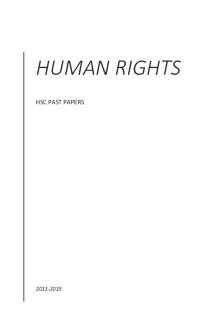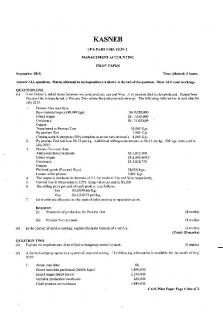Law-of-evidence - Past papers PDF

| Title | Law-of-evidence - Past papers |
|---|---|
| Course | evidence law |
| Institution | University of Nairobi |
| Pages | 5 |
| File Size | 245.7 KB |
| File Type | |
| Total Downloads | 876 |
| Total Views | 1,011 |
Summary
THEUNIVERSITY OFNAIROBIUNIVERSITYSUPPLEMENTARYEXAMINATIONS FOR THE2011-2012 ACADEMICYEARSECONDYEAREXAMINATIONS FOR THEDEGREE OFBACHELOR OFLAWSGPR 201: EVIDENCEIDATE: WEDNESDAY 29 THAUGUST 2012 TIME: 9:00—11.00A.INSTRUCTIONS:(a)Answer Question 1 and any other TWO questions. (b)Support each of your an...
Description
THE UNIVERSITY OF NAIROBI UNIVERSITY SUPPLEMENTARY EXAMINATIONS FOR THE 2011-2012 ACADEMIC YEAR SECOND YEAR EXAMINATIONS FOR THE DEGREE OF BACHELOR OF LAWS GPR 201: EVIDENCE I DATE: WEDNESDAY 29TH AUGUST 2012
TIME: 9:00—11.00 A.M.
INSTRUCTIONS: (a) Answer Question 1 and any other TWO questions. (b) Support each of your answers with relevant case law, statutory provisions and/or any other relevant authorities. (c) Marks may be lost for illegibility, prevarication or vagueness. (d) Your answer sheet must bear your Student Registration Number.
1
“A, who witnessed an act of dangerous driving, some weeks later said to B that the car in question was blue and at the same time made a written note to the same effect. B reported to C what A had said to him. If A is subsequently called as a witness in proceedings concerned with the incident in question, he may of course make a statement from the witness box in the course of giving his evidence to the effect that the colour of the car he saw was blue. Evidence may not be given, however, by A, B, or C of the oral statement made by A out of court. Likewise, the written statement made by A is inadmissible. if A were to give evidence that the car in question was blue, and it were suggested to him in cross-examination that his evidence had been recently fabricated, his former out-of-court statements would be admissible, but not as evidence that the car was in fact blue. If A were to give evidence that the car in question was red, and under cross-examination about his previous out-of-court statements were to deny having made them, they could be proved against him, again not as evidence that the car was in fact blue.” _____ANONYMOUS Discuss
2
30 MARKS
Briefly outline the rules of evidence that govern each of the following: (a) Attestation and execution of documents
( 4 MARKS)
(b) Documentary evidence and parol/extrinsic evidence.
(4 MARKS)
(c) Stamp duty and unstamped documents
( 4 MARKS)
(d) Written hearsay.
(4 MARKS)
(e) proof of execution/attestation of documents that are more than 20 years old.
3
(4 MARKS)
“The modern law of competence and compellability of witnesses may be stated in two general rules. The first is that any person is a competent witness in any legal proceedings. The second is that all competent witnesses are compellable. At common law, there were numerous exceptions to these two general rules. The exceptions have been slowly whittled down by judicial and statutory reforms over the last two centuries, but some of them still persist to the present day.”___ Anonymous. DISCUSS
4
20 MARKS
“The main general rule governing the entire subject [of Evidence Law] is that all evidence that is sufficiently relevant to an issue before the court is admissible and that all that is irrelevant, or insufficiently relevant, should be excluded…The general rule that all relevant evidence is admissible is subject to numerous exceptions because ‘our law…undoubtedly excludes evidence of many matters which anyone in his own daily affairs of moment would regard as important in coming to a decision.’”___ Taper, C. (2010) Cross & Tapper on Evidence, 12th Edition, Oxford University Press, New York, at pp. 64-66. Discuss any four of the “numerous exceptions” alluded to by the eminent author. 20 MARKS
5
Discuss the rule in Jon Makin & Another v Attorney General for New South Wales [1894] A. C. 57 and the extent to which the rule has been adopted as part of the Kenyan Law on Evidence.
20 MARKS.
THE UNIVERSITY OF NAIROBI UNIVERSITY SUPPLEMENTARY EXAMINATIONS FOR THE 2011-2012 ACADEMIC YEAR SECOND YEAR EXAMINATIONS FOR THE DEGREE OF BACHELOR OF LAWS GPR 201: EVIDENCE I DATE: WEDNESDAY 29TH AUGUST 2012
TIME: 9:00—11.00 A.M.
MARKING SCHEME 1
Question one tests the students’ knowledge of the following basic concepts: (a) The rule against admission of hearsay evidence (including both oral and written hearsay) its justifications and exceptions as demonstrated by— i. Sections 33 and 63 of the Evidence Act; ii. Teper v R, Myers v DPP, Sabramanium v DPP, Bedingfield v R or any other relevant authority. (b) The (common law) rule against the giving of evidence of previous consistent or self-serving statements during examination-in-chief as demonstrated by— i. Sections 153 and 165 of the Evidence Act; ii. R v Lillyman [1896] 2 Q.B. 167; or iii. Any other relevant authority. (c) The rule as to cross-examination on previous inconsistent statements and the implications of suggesting to witnesses that their testimony is a recent fabrication as demonstrated by— i. Sections 153 and 165 of the Evidence Act; ii. R v Athwal & Another [2009] 1 WLR 2430; or iii. Any other relevant authority.
2
Question two tests the students’ knowledge of the following basic rules: (a) The requirement to prove due execution and attestation of douments before relying on their contents, as demonstrated by ss. 70-71 of the Evidence Act or any other relevant authority. The rule that parol or
extrinsic evidence is inadmissible where its effect would be to add to, subtract from, vary or contradict the express terms of a written document between the parties as demonstrated by— (b) The rule as to the inadmissibility in evidence of unstamped documents where such documents are liable to stamp duty as set out in sections 19-20 of the Stamp Duty Act (Cap. 480 of the Laws of Kenya). (c) The applicability of the rule against hearsay to documents, as demonstrated by the majority decision of the House of Lords in Myers v DPP. (d) The rule/presumption as to the due execution and attestation of documents that are more than twenty years old when such documents emanate from proper custody, as demonstrated by section 96 of the Evidence Act.
3
Question three tests the students’ knowledge of the exceptions to the general rule that every person is a competent witness and that all competent witnesses are compellable, including: (a) The rule that children of tender years are incompetent if they do not understand the nature of the oath and are not possessed of sufficient knowledge to justify the reception of their evidence, as set out in sections 124-125 of the Evidence Act and section 19 of the Oaths and Statutory Declarations Act or any other relevant authority; (b) The rule that parties and their spouses are competent witnesses in both civil and criminal proceedings, and the qualifications to the compellability of spouses as prosecution witnesses, as set out in section 127 of the Evidence Act or any other relevant authority; (c) The rule that insane persons are competent witnesses unless their condition prevents them from understanding the questions put to them or giving rational answers to those questions, as set out in section 126 of the Evidence Act or any other relevant authority; (d) The rule that although foreign sovereigns, diplomatic and consular officials are competent witnesses, they are not compellable, as demonstrated by the Vienna conventions on diplomatic and consular relations or any other relevant authority.
4
Question four tests the candidates knowledge of at least four exceptions to the general rule that all relevant evidence is admissible, including— (a) Hearsay evidence; (b) Character evidence; (c) Opinion Evidence; (d) Illegally or unfairly obtained evidence; and (e) Similar facts evidence, etc.
5
Question five tests the students’ knowledge of the— (a) The exclusionary part of the rule in the Makin to the effect that it is incompetent for the prosecution to adduce evidence tending to show that the accused has been guilty of crimes other than those charged in the indictment for the purpose of leading to the conclusion that the accused is a person likely from his past or character to have committed the particular offence with which he is charged; (b) The inclusionary part of the rule in the Makin case to the effect that the mere fact that evidence tends to show the commission of crimes other than the one currently charged in the indictment does not render it inadmissible if it is relevant to an issue before the court, and it is so relevant where it bears upon the question whether the acts charged in the indictment were designed or accidental, or to rebut a defence that would otherwise be available to the accused. (c) The codification of the rule in sections 14 and 15 of the Kenyan Evidence Act and the various uses to which similar facts evidence can be put as demonstrated by Smith v R, R v Straffen, Achieng v Republic, R v Armstrong; etc....
Similar Free PDFs

9706 past papers
- 28 Pages

Past exams papers 2
- 10 Pages

Past Papers Human Rights
- 14 Pages

AC100 - Past exam papers
- 15 Pages

Management Accounting Past Papers
- 38 Pages

CRIMINAL LAW PAST PAPERS
- 4 Pages

Topical past papers
- 27 Pages

Accounting 100 past papers
- 2 Pages

acca sbr past papers practice
- 49 Pages

Law-of-evidence - Past papers
- 5 Pages

Unit 1 chemistry past papers
- 12 Pages

Past Papers for Social Studies
- 25 Pages

CSS past papers for islamiat
- 25 Pages

N5 Biology all 2018 - past papers
- 48 Pages
Popular Institutions
- Tinajero National High School - Annex
- Politeknik Caltex Riau
- Yokohama City University
- SGT University
- University of Al-Qadisiyah
- Divine Word College of Vigan
- Techniek College Rotterdam
- Universidade de Santiago
- Universiti Teknologi MARA Cawangan Johor Kampus Pasir Gudang
- Poltekkes Kemenkes Yogyakarta
- Baguio City National High School
- Colegio san marcos
- preparatoria uno
- Centro de Bachillerato Tecnológico Industrial y de Servicios No. 107
- Dalian Maritime University
- Quang Trung Secondary School
- Colegio Tecnológico en Informática
- Corporación Regional de Educación Superior
- Grupo CEDVA
- Dar Al Uloom University
- Centro de Estudios Preuniversitarios de la Universidad Nacional de Ingeniería
- 上智大学
- Aakash International School, Nuna Majara
- San Felipe Neri Catholic School
- Kang Chiao International School - New Taipei City
- Misamis Occidental National High School
- Institución Educativa Escuela Normal Juan Ladrilleros
- Kolehiyo ng Pantukan
- Batanes State College
- Instituto Continental
- Sekolah Menengah Kejuruan Kesehatan Kaltara (Tarakan)
- Colegio de La Inmaculada Concepcion - Cebu

